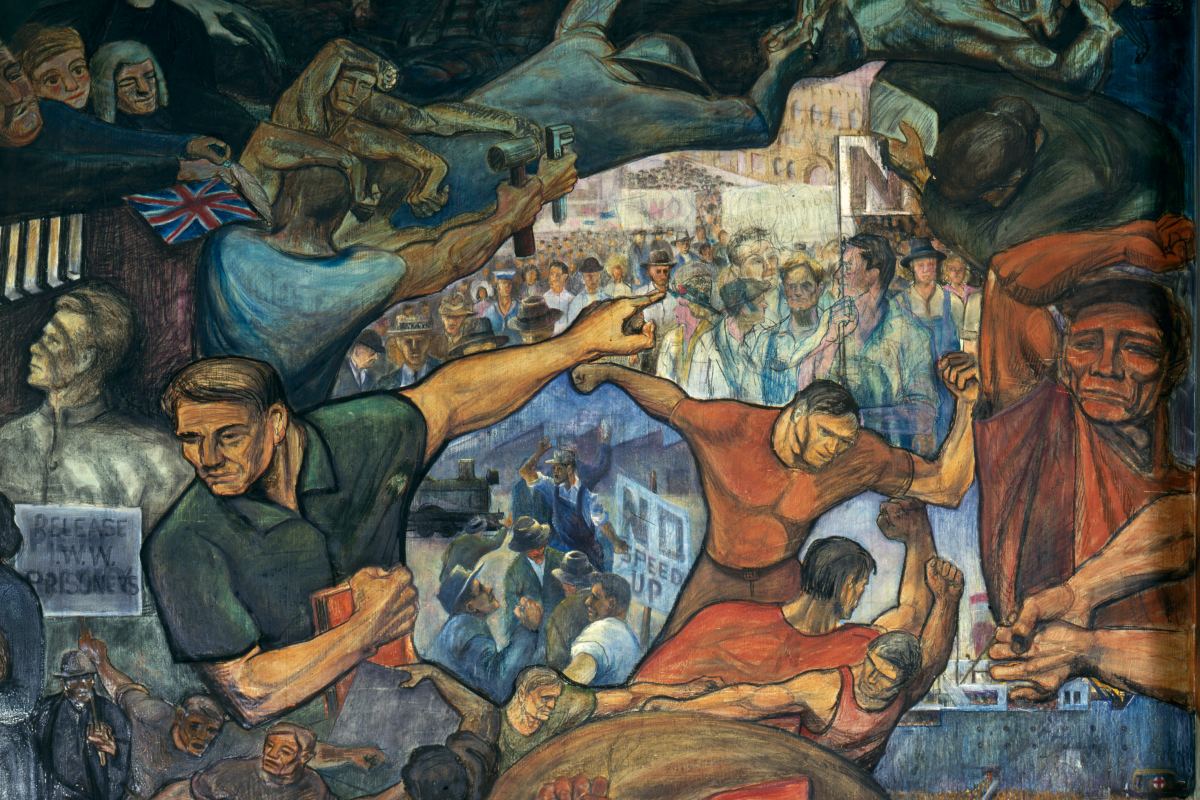
The historic mural telling the story of Australia’s “unsung heroes”

Image: The Maritime Museum is displaying a historic mural to celebrate the 150th anniversary of the Maritime Union. Photo: Australian National Maritime Museum.
By ERIN MODARO
This month, the Maritime Union marked its 150th anniversary, and in recognition of its long history, the Maritime Museum in Sydney is displaying a historic mural painted by union members in the 1950s and 60s.
Sydney, defined by its winding foreshore that sits glittering in the background of its landmarks, was shaped by the blue collar workers toiling on the waters of its harbour.
Painted over several years by 9 union artists, the mural decorated the walls of the canteen at 60 Sussex Street where ‘wharfie’s’, or dock workers, would eat and socialise. Significant faces, events and ideas of the 20th century are boldly featured across its 9 panels.

The canteen mural, formerly located in the heart of Sydney’s docks where Barangaroo is now, was started in 1953, with additions being added for over a decade after. Workers sat under the mural throughout the 20th century, until the building was set to be demolished in 1991, and the paintings were carefully removed from the walls and placed in storage.
Paul Keating, Secretary of the Maritime Union Sydney Branch, said that he can imagine what it would have been like to see the mural in its birthplace.
“I can imagine the moms and the dads the waterside workers, their wives, and children coming into the canteen and seeing that picture, seeing that mural and understanding how profound it was” Keating told City Hub.
“It’s a masterpiece for historical reasons” he said.
The brushstrokes of the mural tell the story of dockworker’s optimism, their dedication to improving the lives of working class Australians. Painted in the style of Soviet art, as the revolution swept through Russia and spread Marxist culture and politics across the globe, the figures in the mural display the soul of Australian revolution.
The Socialist Realism style of the mural was “intended to depict historical events from a worker’s perspective and to evoke the spirit of solidarity”, said exhibition curator Holly Williams.
“As an artwork, it speaks to the aims and aspirations of the union at the time it was created.”

The history of the Maritime Union
Trade unions began forming in Australia in the late 19th century, with the official formation of the Waterside Workers’ Federation (WWF) coming in 1902. The WWF was the first maritime union ever established.
The aspirations of the union included the adoption of the 8 hour work day, which is depicted on one mural panel next to the formation of the Australian Labor Party in the 1890s. In 1917, as oceans away Bolsheviks stormed the Winter Palace overturning hundreds of years of Romanov rule, Sydney’s workers were striking for their rights in Eveleigh train-yards.
The despair and poverty brought on by The Great Depression is also illustrated, next to panels marking the shift of world powers throughout the 20th century. The atrocities of the Holocaust are displayed as the Dachau concentration camp is adjacent to a scarlet Nazi armband.

The toiling workers of the mural reflect the harsh physical labour that characterised working on Sydney’s docks.
“Several sections address the physically harsh and dangerous working conditions for wharfies” Williams said.
An island nation, shipping routes marked the connection for Australia to the rest of the world, and massive amounts of labour were needed to keep the industry running.
The overturning of exploitative conditions was integral to the union’s fight.
Keating recognised the end of the “bull system”, in which the strongest men would get the most work, as a significant achievement for the union.
“Usually only the strongest and more compliant workers were chosen, leaving the others to go hungry” Williams explained. The hunger of workers under the “bull” system led to the long walk down the Darling Harbour docks being deemed ‘The Hungry Mile’.
Waterside Worker’s Film Unit
The Maritime’s Union was not only a facilitator of politics, but also of culture. 16 cultural groups formed within the union to nurture socialist ideas, pushing for social change, and expressing the experiences of working class Australians.
During the height of the cold war, when anti-communist and anti-worker rhetoric was broadcast through mainstream media, three union members collaborated to form the Waterside Workers’ Federation Film Unit in 1953. The Film Unit’s works would go on to be a lasting monument to the union, as their most influential film, The Hungry Mile, is referenced in the mural.
Norma Disher, Keith Gow and Jock Levy would produce three films in the 1950s, with one more film produced in 1981 by their successors in the Wharfie’s Film Unit.
Lisa Milner, a Labor historian and author, said that the visual medium of film made it a powerful conduit for sharing ideology.
“It’s important that the history of a very important union in Australian political and industrial history gets to be seen on screen” Milner said.
“The film unit has had a lasting impact on both the political and cultural history of Australia.”
Today, the films produced by the Wharfie’s Film Unit are looking-glasses into the past experiences of the working class.
“Because the films have been digitised we get to enjoy that legacy for a long time to come” Milner said.










